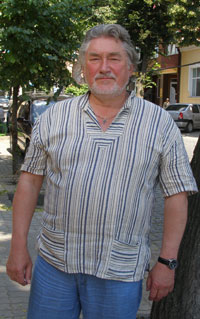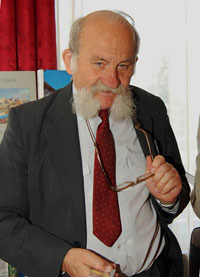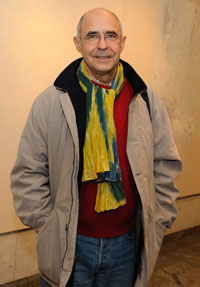 A.Chebykin, Academician, President of the Academy of Art of Ukraine People's Artist of Ukraine T.Shevchenko National Prize Laureate
A.Chebykin, Academician, President of the Academy of Art of Ukraine People's Artist of Ukraine T.Shevchenko National Prize Laureate
"Art is cooperation of Lord and artist and the less is the part of artist – the better."
Henri Matisse
Every time I go to Transcarpathia with great pleasure, anticipating the meeting with a wonderful picturesque region – the region of splendid mountains, transparent swift rivers, green grasslands. There are also unique towns of Uzhhorod, Mukachevo, Berehovo and a multinational society of different languages and different voices. All this makes an inimitable impression, inspires the creative work, rouses fresh thoughts.
We meet in the circle of friends, who are the successors of the brilliant Transcarpathian art school, whose inspirers and founders were M.Munkachi in the 19th century and later in the 20th century – A. Erdeli, Y.Bokshay, F.Manaylo and other their colleagues, friends, brothers of brush.
The foundation of the Transcarpathian State Art Institute in 2003, that has grown up on the traditions of Uzhhorod Art School and later A.Erdeli College of Arts has become an important event.
Ivan Nebesnyk, the rector of the newly formed institute makes a lot to respect the memories of Adalbert Erdeli and other representatives of Transcarpathian art school, he investigates the history of art education in the region, stimulates teachers and students to the scientific work.
It is already a tradition to hold conferences under the title "Erdeli readings" which gather artists and art historians from all over Ukraine and from abroad. These meetings, scientific discussions, discoveries reflect the new aspects of the unique phenomenon which Transcarpathian painting is.
So I wish the Transcarpathian fine art, the Transcarpathian art school to keep the high level and I wish the young generation of Transcarpathian artists to reach new creative achievements.
 Andriy Bokotey, rector of Lviv Academy of Art, Honoured Art Worker of Ukraine, member of the Academy of Arts of Ukraine, T. Shevchenko National Prize of Ukraine laureate
Andriy Bokotey, rector of Lviv Academy of Art, Honoured Art Worker of Ukraine, member of the Academy of Arts of Ukraine, T. Shevchenko National Prize of Ukraine laureate
I am happy that I was borm in Transcarpathia in the village of Brid, Irshava district. The most important emotions, absorbed from the communication with this beautiful land and its wonderful people, always remain in my heart. One cannot retell the impressions from the deep wisdom of the people. It breathes, laughs and cries in the art pieces created by the experienced masters. It's a work for a long time for the contemporaries and future generations to study and analyze it.
Transcarpathia is a unique region. Good climate, the richness of land, the beauty of landscapes – gardens, groves, the space of highlands – everything here inspires for creative work. And how precious is the culture that we have inherited from our ancestors: features of everyday life, customs and ceremonies. In other words – the whole of the spiritual and material traditions of our people. At least five cultures have crossed here, and the fates of Czech, Hungarian, Ukrainian and other nations were united in the common history. It is of vital importance that there have never been international conflicts in this part of Ukraine. On the contrary – the neighbouring cultures have coexisted and enriched one another. And here is the last very important moment – the artistic abilities of the people. This factor is a logical conclusion from all the previous. At the art exhibitions of Transcarpathian artists you can always feel this inimitable tonality of the Transcarpathian folk art. All this taken together is the motive power of the art progress.
 Oleksandr Fedoruk, member of the Academy of Arts of Ukraine, PhD (history of art), editor-in-chief of the "Fine Art" magazine.
Oleksandr Fedoruk, member of the Academy of Arts of Ukraine, PhD (history of art), editor-in-chief of the "Fine Art" magazine.
Originality of images, brightness of form, clearness of composition – these are the peculiar features of the works of the renowned Transcarpathian art school masters Adalbert Erdeli, Yosyp Bokshay, Fedir Manaylo, Andriy Kotska, Zoltan Sholtes, Havrylo Hlyuk, Ernest Kontratovych, Anton Kashay, Liza Kremnytska, Vasyl Habda, Shandor Petki, Volodymyr Mykyta, Ivan Shutev, Pavlo Bedzir. Fundamental basis of pictorial thinking was laid by the artists who were trying to create the art that would depict the original features of the native land, everyday life and traditions of the people, characteristic features of the landscape. The canvases of these artists aroused trust, they charmed and astonished in a pleasant way, and the spectator's eye could not be indifferent. The group of Transcarpathian painters has always been representative and leading in the context of Ukrainian art culture of the 20th century. The same one can say about their talented successors who are among the leading artists of our state. They are Yuriy Herts, Vasyl Skakandiy, Yosyp Harani, Taras Danylych, Ivan and Larysa Brovdi, Liudmyla Korzh-Radko, Borys Kuzma, Zoltan Michka, Myroslava Rosul, Mykhailo Peyter, Vasyl Svalyavchyk, Petro Feldeshi, Terezia Chuvalova, Vasyl Sidak and others.
Transcarpathian art school is a vivid phenomenon in the Ukrainian art of the beginning of the new century. As a well-known poet Petro Skunts marked – "The Transcarpathian art is in the hands of talented and thoughtful masters". And let their own concepts, creativity, individual manners and art techniques favour the preservation and renewal of the pictorial art of Transcarpathia.
 M. Mushynka, PhD, foreign member of the National Academy of Sciences of Ukraine, professor of Presov University, Slovakia:
M. Mushynka, PhD, foreign member of the National Academy of Sciences of Ukraine, professor of Presov University, Slovakia:
”There cannot be any doubt about the existence of the ”Transcarpathian school of painting”. It has been already known far outside the region in the period between the wars due to the personal and group exhibitions of its members in Prague, Kosice, Budapest and other cities. I mean the members-founders of the school such as Erdeli, Bokshay, Manaylo, Kotska, Hrabovskiy, Kontratovych, whose works are pesented in many museums, galleries and private collections in Slovakia. The paintings of Transcarpathian artists are of great value at world auctions and they do not appear any more at Transcarpathian market.
Though formally the official ”socialist realism” was declared, the Transcarpathian school preserved its identity and originality in the postwar years. Its representatives were such artists as Hluk, Habda, Herts, Kashay, Mykyta, Boretskiy and many others. Their works are highly appreciated outside Ukraine. The announcements like ”The paintings of Transcarpathian artists wanted” have been found in the foreign press for many years. The evidence of the high level of the Transcarpathian school of painting is the fact that some of its ”graduates” took up high positions in the world of art. Mykhaylo Romanyshyn (my friend since the first half of the 1960s), for instance, was the director of the Ukrainian Art Museum in Kyiv for many years and Voytech Kalna, the disciple of Erdeli, Bokshay and Manaylo, was the director of East Slovakian Art Gallery in Kosice.
During last 10–15 years a number of Transcarpathian artists try to draw away from native traditions and follow blindfold the so called "modern" art of the West, which is very often of dubious value.
It's paradox, but you would see more of real Transcarpathian school of painting in Teatralna square in Uzhhorod than at exhibitions. For a pity you meet the same phenomenon in all European countries including Czech Republic and Slovakia. I would call it a fashion, not an art. The art which does not come from national traditions is not lasting.
 Tiberiy Silvashi, a painter well-known in Ukraine and abroad, native of Transcarpathia, Kyiv
Tiberiy Silvashi, a painter well-known in Ukraine and abroad, native of Transcarpathia, Kyiv
There are places in the world where you especially strongly feel its irrational attraction. And the phrase "I remember" threatens to turn into excessiveness of context. You never come back here the same man you were when you were leaving, carrying with you the trains of disappointments. Here memory is equal to oblivion and archaic, visible through the signs of civilization, is transforming into special artistic space. In these places magic and art present the great illusion of contact with eternity, as it was in the ancient times when they formed one whole.
When we say "Transcarpathian school", we mark out "Transcarpathian", thus emphasizing the peculiar status, imparting a certain generic distinction. As far as I can see, this notion is connected not only with the concrete topos but also with a certain historic period. And also with concrete names. Tetyna Yablonska told me how impatiently she was waiting for the works of "Transcarpathians" at every exhibition in 1950s and later. This was the "different" of Kyiv school. "Fathers-founders" of the Transcarpathian school had behind them the traditions of Paris, Praque, Vienna, Budapest. The tradition of European colours was interpreted here in a different way than in Kyiv. A special feeling of colour and landscape peculiarities lie in the basis of this school. Let us add here the energetics pulsating in this space, a trembling of the epochs perceptible even on the physical level, the presence of myth. This is the basis. The following text of "Transcarpathian school" is being written by the others. In the dialogues with those who were beginning. In the arguments and discussions, in extending the language, in introducing the new materials and concepts. Because "school" is a living organism.








